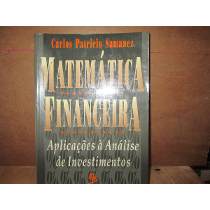Carlos Patricio Samanez Matematica Financeira Pdf
Method and the form or tooling required for each operation. Devise the best way to combine the operations and put them in sequence. Specify the gauging required for the process. Steps 3–5 aim to determine the most practical and economical sequence of operations to produce a component.
This concept is demonstrated with a numerical problem. EXAMPLE 2.6 The process planning engineer of a firm listed the sequences of operations as shown in Table 2.3 to produce a component. Table 2.3 Data for Example 2.6 Sequence Process sequence 1 Turning – Milling – Shaping – Drilling 2 Turning – Milling – Drilling 3 All operations are performed with CNC machine Elementary Economic Analysis 23 The details of processing times of the component for various operations and their machine hour rates are summarized in Table 2.4. Table 2.4 Machine Hour Rates and Processing Times (minutes) for Example 2.6 Operation Machine hour Process sequence rate (Rs.) 1 2 3 Turning 200 5 5 – Milling 400 8 14 – Shaping 350 10 – – Drilling 300 3 3 – CNC operations 1,000 – – 8 Find the most economical sequence of operations to manufacture the component. Solution (a) Cost of component using process sequence 1. The process sequence 1 of the component is as follows: Turning – Milling – Shaping – Drilling The calculations for the cost of the above process sequence are summarized in Table 2.5.

Table 2.5 Workings for Process Sequence 1 Operation Operation Time Machine Cost No. Hour rate (min) (hr) (Rs.) (Rs.) 1 Turning 5 0.083 200 16.60 2 Milling 8 0.133 400 53.20 3 Shaping 10 0.167 350 58.45 4 Drilling 3 0.050 300 15.00 Total: 143.25 (b) Cost of component using process sequence 2. The process sequence 2 of the component is as follows: Turning – Milling – Drilling The calculations for the cost of the above process sequence are given in Table 2.6. 24 Engineering Economics Table 2.6 Workings for Process Sequence 2 Operation Operation Time Machine Cost No. Hour rate (min) (hr) (Rs.) (Rs.) 1 Turning 5 0.083 200 16.60 2 Milling 14 0.233 400 93.20 3 Drilling 3 0.050 300 15.00 Total: 124.80 (c) Cost of component using process sequence 3. The process sequence 3 of the component is as follows: Only CNC operations The calculations for the cost of the above process sequence are summarized in Table 2.7 Table 2.7 Workings for Process Sequence 3 Operation Operation Time Machine Cost No.
Hour rate (min) (hr) (Rs.) (Rs.) 1 CNC operations 8 0.133 1,000 133 The process sequence 2 has the least cost. Therefore, it should be selected for manufacturing the component. List and explain the different situations deserving elementary economic analysis. Explain the steps in the process planning.

In the design of an aircraft jet engine part, the designer has a choice of specifying either an aluminium alloy casting or a steel casting. Either material will provide equal service, but the aluminium casting will weigh 5 kg as compared with 7 kg for the steel casting. The aluminium part can be cast for Rs.
Projects related to Energy and Green Technologies. Bibliographic Data. Oliveira, Erick Meira de. Corporate Social Responsibility and Firm. Performance: a case study from the Brazilian Electric. Sector / Erick Meira de Oliveira; advisor: Carlos Patricio. Samanez; co-advisor: Marcelo Alvaro da Silva Macedo.
125 per kg and the steel part can be cast for Rs. The cost of machining per unit is Rs. 200 for the aluminium part and Rs.
250 for the steel part. 3d Driving School License Expired Nj more. Every kilogram of excess weight is associated with a penalty of Rs.
2,500 due to increased fuel consumption. Which material should be specified and what is the economic advantage of the selection per unit? Two alternatives are under consideration for a hexagonal bolt fastening pin. Either design will serve equally well and will involve the same material and manufacturing cost except for the lathe and grinder operations. Elementary Economic Analysis 25 Design A will require 20 hours of lathe time and 8 hours of grinder time per 10,000 units. Design B will require 10 hours of lathe time and 22 hours of grinder time per 10,000 units.
The operating cost of the lathe including labour is Rs. 400 per hour. The operating cost of the grinder including labour is Rs.
300 per hour. Which design should be adopted if 10,00,000 units are required per year and what is the economic advantage of the best alternative? A building contractor can source door frames from either a nearby shop or a far-off forest area.
The cost details are as summarized in the following table. The total requirement of wood for the construction work is 75 tons. Items Nearby shop Far-off forest area Distance to site Negligible 900 km Transportation cost per ton per km Negligible Rs. 100 Material cost/ton Rs. 1,250 Find the best alternative for buying the wooden frames. Also find the economic advantage of the best decision. Consider Example 2.4.
Rework this example if the ratio of the height to diameter corresponding to the minimum cost is 6:1 instead of 4:1. The process planning engineer of a firm listed down the sequences of operations, as shown in the following table to produce a component: Sequence Process sequence 1 Turning – Milling – Shaping – Drilling 2 Turning – Milling – Drilling 3 All operations are performed with CNC machine The details of process time for the components for various operations and their machine hour rates are tabulated now.
Operation Machine hour Process sequence rate (Rs.) 1 2 3 Turning 300 8 8 Milling 350 10 14 Shaping 380 12 Drilling 350 5 5 CNC operation 1,200 10 Find the most economical sequence of operations to manufacture the component. 26 � INTEREST FORMULAS AND THEIR APPLICATIONS 3.1 INTRODUCTION Interest rate is the rental value of money. It represents the growth of capital per unit period. The period may be a month, a quarter, semiannual or a year.
An interest rate 15% compounded annually means that for every hundred rupees invested now, an amount of Rs. 15 will be added to the account at the end of the first year. So, the total amount at the end of the first year will be Rs.
At the end of the second year, again 15% of Rs. 17.25 will be added to the account. Hence the total amount at the end of the second year will be Rs. The process will continue thus till the specified number of years.
3.2 TIME VALUE OF MONEY If an investor invests a sum of Rs. 100 in a fixed deposit for five years with an interest rate of 15% compounded annually, the accumulated amount at the end of every year will be as shown in Table 3.1. Table 3.1 Compound Amounts (amount of deposit = Rs. 100.00) Year end Interest Compound amount (Rs.) (Rs.) 0 100.00 1 15.00 115.00 2 17.25 132.25 3 19.84 152.09 4 22.81 174.90 5 26.24 201.14 The formula to find the future worth in the third column is F = P � (1 + i)n where P = principal amount invested at time 0, F = future amount, Interest Formulas and Their Applications 27 i = interest rate compounded annually, n = period of deposit. The maturity value at the end of the fifth year is Rs.
This means that the amount Rs. 201.14 at the end of the fifth year is equivalent to Rs. 100.00 at time 0 (i.e. This is diagrammatically shown in Fig. This explanation assumes that the inflation is at zero percentage.
100 i = 15% 0 1 2 3 4 5 201.14 Fig. 3.1 Time value of money. Alternatively, the above concept may be discussed as follows: If we want Rs. 100.00 at the end of the nth year, what is the amount that we should deposit now at a given interest rate, say 15%? A detailed working is shown in Table 3.2. Table 3.2 Present Worth Amounts (rate of interest = 15%) End of year Present worth Compound amount (n) after n year(s) 0 100 1 86.96 100 2 75.61 100 3 65.75 100 4 57.18 100 5 49.72 100 6 43.29 100 7 37.59 100 8 32.69 100 9 28.43 100 10 24.72 100 The formula to find the present worth in the second column is P = F i n(1 + ) From Table 3.2, it is clear that • • • 7 • • • •.
Why is Chegg Study better than downloaded Matematica Financeira PDF solution manuals? It's easier to figure out tough problems faster using Chegg Study. Unlike static PDF Matematica Financeira solution manuals or printed answer keys, our experts show you how to solve each problem step-by-step.
No need to wait for office hours or assignments to be graded to find out where you took a wrong turn. You can check your reasoning as you tackle a problem using our interactive solutions viewer. Plus, we regularly update and improve textbook solutions based on student ratings and feedback, so you can be sure you're getting the latest information available. How is Chegg Study better than a printed Matematica Financeira student solution manual from the bookstore? Our interactive player makes it easy to find solutions to Matematica Financeira problems you're working on - just go to the chapter for your book.
Hit a particularly tricky question? Bookmark it to easily review again before an exam. The best part? As a Chegg Study subscriber, you can view available interactive solutions manuals for each of your classes for one low monthly price. Install Libusb Windows 10. Why buy extra books when you can get all the homework help you need in one place?